#universal mobile coverage
Explore tagged Tumblr posts
Text
Vi Teams Up With AST SpaceMobile Amid Starlink’s Entry Into India, Shares In Focus
Last Updated:June 19, 2025, 08:05 IST VI shares gain attention after partnering with AST SpaceMobile for satellite connectivity in India, aiming to enhance mobile coverage. The satellite-based service could be a game changer for telecom access in India’s rural pockets, forest areas, deserts, and hilly regions. Vi Share Price: Telecom operator VI shares are in the spotlight on Thursday, after…
#AST SpaceMobile#Digital India mission#satellite connectivity#space-based cellular technology#telecom operator#universal mobile coverage#VI shares#Vodafone Idea
0 notes
Text
It's important to know what is going on.
Written by US Senator Chris Murphy (D - CT)

Report from the Senate Floor:
Last night in the Senate, something really important happened. Republicans forced us to debate their billionaire bailout budget framework. We started voting at 6 PM because they knew doing it in the dark of night would minimize media coverage. And they do not want the American people to see how blatant their handover of our government to the billionaire class is.
So I want to explain what happened last night and what we did to fight back. The apex of Republicans’ plan to turn over our government to their wealthy cronies is a giant tax cut for billionaires and corporations. And they plan to pay for it with cuts to programs that working people rely on. Popular and necessary programs like Medicaid, Medicare, and SNAP, are all being targeted.
In order to pass the tax cut, Republicans have to go through a series of procedural steps. Last night, they took the first step which requires them to pass an outline of their plan, but with it, any senator can offer as many amendments as we want. So my Democratic colleagues and I did just that.
Now, we knew that Republicans would largely unanimously oppose them, but we had two objectives here. One, Republicans were forced to put their opinion on record — many for the first time — on the most corrupt parts of Trump and Musk’s agenda. Two, as I’ve been saying, I am going to make every process and procedure as slow and painful as possible for as long as my colleagues choose to ignore the constitutional crisis happening before our eyes.
So what did we propose? We proposed no tax cuts for anyone who makes a billion dollars a year. We made them vote on whether or not Elon Musk and DOGE should have limitless access to Americans’ personal data. We made them vote on whether to protect IVF and require insurers to cover it. Every single amendment Democrats proposed was shot down. On almost every single amendment, Republicans universally opposed it. Every Republican voted against our proposal to prevent more tax cuts for billionaires. The corruption and theft is happening in the open here.
The whole game for Republicans is taking your money and giving it to the wealthiest corporations and billionaires — even if it means kicking your parents out of a nursing home or turning off Medicaid for the poorest children. They know what they are doing is deeply unpopular. They are offering a tax cut to the most wealthy that is 850 times larger than what they are offering working people. Oh and by the way, any tax cuts for working people are going to be washed out by higher costs for basic necessities, like health care and food. It’s a fundamental injustice.
Thanks to your pressure and support, many of my Democratic colleagues have joined my effort to do everything we can to make sure they cannot destroy democracy and steal your money in the dark of the night. We are being loud about what is happening. I’m going to continue to grind the gears of Congress down as much as possible to make it that much harder and slower to get away with this corruption. That’s why the votes lasted until nearly 5 AM.
This is a five-alarm fire. I don’t think we have two years to plan and fight back. I think we have months. It’s still in our power to stop the destruction of our democracy with mass mobilization and effective opposition from elected officials. So we can’t miss any opportunity to take advantage of opportunities to put Republicans on the record and shine a light on what is happening.
And you have a role to play in this as well. I need you to amplify what’s happening, support the leaders who are fighting for you to make sure they can continue speaking truth to power against Musk and Trump’s billionaire cronies, and show up at rallies and town halls. Use every tool at your disposal to send a message loud and clear about how you expect my colleagues to lead and fight in this moment.
Every best wish,
US Senator Chris Murphy (D - CT)
#chris murphy#democrat from Connecticut#grind their gears#make them own their shitty opinions#publicly#support your dems#usa in crisis#constitutional crisis
4K notes
·
View notes
Text
THAT'S IT! This is a Janet Drake Defense Post
As may be obvious, I spend a lot of time reading fanfic. And there's this trend that drives me nuts, and it's villainizing Janet Drake.
I'm not gonna say she's an A+ mother. She's not. She chose her career and adventures over spending time with her child much of the time. But fandom portrays her as some rich pompous ice queen, which is never shown.
Janet Drake mostly appears in the story Tim's introduced, and in the story she dies.
So, let's start from the top: Haly's Circus.

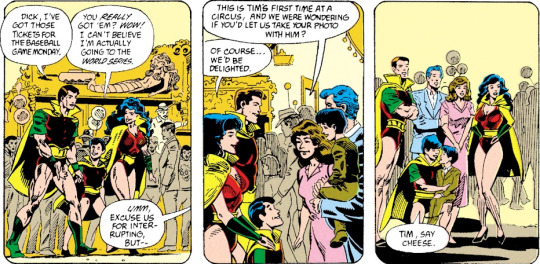
This event is the only time we see her really interacting with Tim before her death, but it shows that at least when he was young, she was an active part of his life. She was worried about bringing Tim because it might scare him. And then rightfully scolds her husband for being sexist because Jack Drake actually IS a jerk.
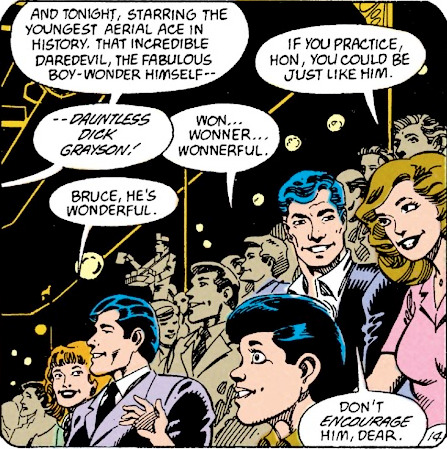
...I don't like the art in this comic. Or that the writer doesn't know how kids speak.
But Janet is being supportive of Tim's clear interest in Dick's performance.
And then tragedy strikes and she acts like, y'know, a mother.

Her priority is getting her son and herself out of there.
Also worth noting that the Drakes sent a copy of that final photo of the Graysons TO Dick, which is how he has it at all. If both of them were stuck up pricks, would they even bother sending a photo to a grieving child performer they hardly know? I can't imagine Jack really bothering, but I don't see why Janet wouldn't.
And then, by the time she's dying, we know that Tim's parents have been away for a very long time, he never knows where they are, but they've communicated enough that he knows that they've been fighting.

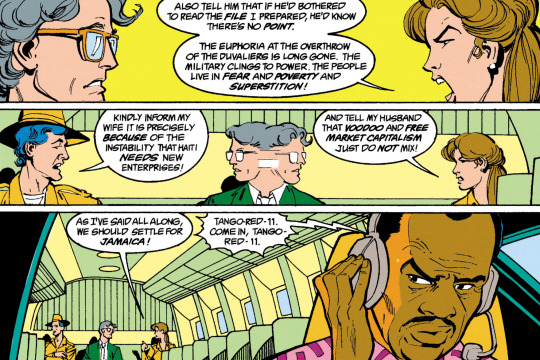
They're passive aggressive to say the least. This marriage is clearly not working anymore.
EDIT CUZ I REMEMBERED A THING:
It's worth noting that this is a time before smartphones. This comic was released in 1990, which was when pre-paid mobile phones had just started existing. Coverage isn't universal NOW, so back then it was even less, and Jack and Janet are archeologists (or archeologist adjacent?) so they're going to be in less developed and populated areas most of the time. It's unlikely they'd have consistent access to a functional phone that could call the states to talk to Tim regularly.
This isn't to defend their absence, because fuck that, but it's to give it some context. I don't think they were trying to ignore or abandon Tim. Communication was just not readily available and Janet seems to get wrapped up in work...and Jack's an asshole.
Also for note, Janet is probably the one sending Tim postcards in the first place. It being signed "Mom and Dad" is what makes me think that. Jack would have put himself first if he wrote it, it woulda said "Dad and Mom". That's admittedly pure speculation, BUT IT FITS SOOOOOO
My thought is if this were made modern, Janet would be sending extremely scattered texts and Tim would get next to nothing from Jack unless Janet prompted him.
END EDIT
(Fair warning, this story is a few levels of Yikes, but I'm gonna stay on topic)
Bad guy Obeah Man does...something? to the pilot, and they crash, and he has a group of people kidnap the Drakes and their assistant Jeremy.

Danger really puts some things in perspective, for Janet, at least. And that continues for her. Jack is a bit delusional and in denial, thinking he has any control of the situation.
They are tied up and filmed for ransom, their assistant killed right in front of them.



Jack just keeps raging, but Janet is having regrets. Notice how she doesn't cry until Tim is brought up. Could be nothing, could be something.
And then she dies.
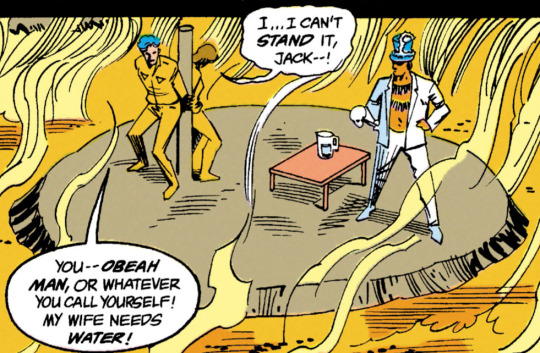

Her only other major appearance is when Tim is having a fever dream from the Clench and everything is kind of okay for a minute.

Tim very clearly loves his mom. And we may not get a lot of characterization for her, but she's not cold or callous like people write her constantly.
And now, we finally have a little more about her as of Batman 134.
I haven't really been keeping up since the Gotham War stuff because What The Fuck Was That My Guy, but I recently saw this specific comic.
The multiverse is fucked up again, some way some how, and Bruce is lost (again) and Tim has to get him back (again). This time, Tim is going in after him. But he doesn't end up going straight to Bruce.
He goes to see an alt of his mom.

Tim missed her so much that he ended up going to her before Bruce.
And her immediate reaction is to run up and hug him. Does that look like a mother who doesn't love her son?

"Do you have anyone to take care of you?"
"I don't know how this happened, this miracle...but I just know, in my heart of hearts, it was to show me...that every version of my son is a good one."
Tell me again that this woman is heartless and didn't want her son, I fucking dare you.

And we get more meaning to the name "Robin" and a little crumb about Tim's grandmother. As a treat.
This is all to say, please stop writing Janet Drake as a cold, heartless bitch.
Small final note though: Jack Drake is, in fact, a shitty person and a shitty father. He does still love Tim and Tim loves him AND THAT IS NOT UP FOR DEBATE, but the relationship is a mess. If either parent is actively abusive, it's 1000% Jack "smashed a TV because my son wasn't listening to me and threatened Bruce Wayne at gunpoint" Drake. Probably part of why the marriage was falling apart.
Anyway, yeah, let's retire the "Jack and Janet Drake are Bad Parents" tag and replace it with "Jack Drake is a Bad Parent" and "Janet Drake's C+ Parenting" or something.
236 notes
·
View notes
Text

Important read. Please share EVERYWHERE.
Report from the Senate Floor:
Last night in the Senate, something really important happened. Republicans forced us to debate their billionaire bailout budget framework. We started voting at 6 PM because they knew doing it in the dark of night would minimize media coverage. And they do not want the American people to see how blatant their handover of our government to the billionaire class is.
So I want to explain what happened last night and what we did to fight back. The apex of Republicans’ plan to turn over our government to their wealthy cronies is a giant tax cut for billionaires and corporations. And they plan to pay for it with cuts to programs that working people rely on. Popular and necessary programs like Medicaid, Medicare, and SNAP, are all being targeted.
In order to pass the tax cut, Republicans have to go through a series of procedural steps. Last night, they took the first step which requires them to pass an outline of their plan, but with it, any senator can offer as many amendments as we want. So my Democratic colleagues and I did just that.
Now, we knew that Republicans would largely unanimously oppose them, but we had two objectives here. One, Republicans were forced to put their opinion on record — many for the first time — on the most corrupt parts of Trump and Musk’s agenda. Two, as I’ve been saying, I am going to make every process and procedure as slow and painful as possible for as long as my colleagues choose to ignore the constitutional crisis happening before our eyes.
So what did we propose? We proposed no tax cuts for anyone who makes a billion dollars a year. We made them vote on whether or not Elon Musk and DOGE should have limitless access to Americans’ personal data. We made them vote on whether to protect IVF and require insurers to cover it. Every single amendment Democrats proposed was shot down. On almost every single amendment, Republicans universally opposed it. Every Republican voted against our proposal to prevent more tax cuts for billionaires. The corruption and theft is happening in the open here.
The whole game for Republicans is taking your money and giving it to the wealthiest corporations and billionaires — even if it means kicking your parents out of a nursing home or turning off Medicaid for the poorest children. They know what they are doing is deeply unpopular. They are offering a tax cut to the most wealthy that is 850 times larger than what they are offering working people. Oh and by the way, any tax cuts for working people are going to be washed out by higher costs for basic necessities, like health care and food. It’s a fundamental injustice.
Thanks to your pressure and support, many of my Democratic colleagues have joined my effort to do everything we can to make sure they cannot destroy democracy and steal your money in the dark of the night. We are being loud about what is happening. I’m going to continue to grind the gears of Congress down as much as possible to make it that much harder and slower to get away with this corruption. That’s why the votes lasted until nearly 5 AM.
This is a five-alarm fire. I don’t think we have two years to plan and fight back. I think we have months. It’s still in our power to stop the destruction of our democracy with mass mobilization and effective opposition from elected officials. So we can’t miss any opportunity to take advantage of opportunities to put Republicans on the record and shine a light on what is happening.
And you have a role to play in this as well. I need you to amplify what’s happening, support the leaders who are fighting for you to make sure they can continue speaking truth to power against Musk and Trump’s billionaire cronies, and show up at rallies and town halls. Use every tool at your disposal to send a message loud and clear about how you expect my colleagues to lead and fight in this moment.
Every best wish,
US Senator Chris Murphy (D - CT)
23 notes
·
View notes
Text
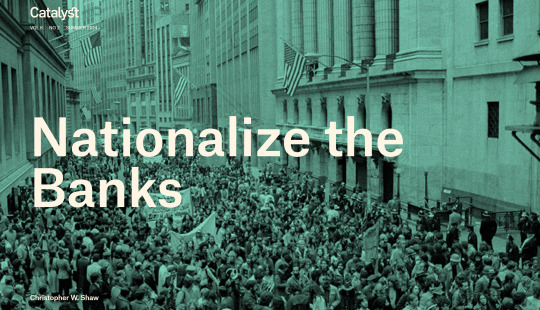
CATALYST JOURNAL
As a lonely critic who dared to challenge Federal Reserve Board chairman Alan Greenspan during the stock market mania of the late 1990s, then congressman Bernie Sanders received recognition from the political left and dismissive coverage from the mainstream media. Sanders subsequently won significant national attention as an outspoken populist critic of the banking system in the wake of the 2007–8 financial crisis. After declaring his presidential candidacy in 2015, he cemented this reputation as the nation’s preeminent critic of bankers, using the campaign to express the anger that many Americans shared about the financial crisis and the resulting bailout. “If elected president,” Sanders pledged, “I will rein in Wall Street so they can’t crash our economy again.”1 Hillary Clinton conceded the appeal of this campaign promise when — panicked by the popularity of Sanders’s attack on finance and unable to respond effectively to his criticisms — she sought to change the subject by exclaiming, “If we broke up the big banks tomorrow . . . would that end racism? Would that end sexism? Would that end discrimination against the LGBT community?”2 The stand that Sanders took against the banks was compelling, true to the contemporary moment, and appeared novel. But although unfamiliar to the times, opposing the excesses and power of bankers was hardly original. Sanders emerged as the successor to an influential strand of American political culture with deep historical roots that has motivated far-reaching economic demands in the past and could do so again in the future.
As the Sanders campaign demonstrated, while banking is widely considered to be dry and dull, it’s nevertheless an issue that can energize working-class politics. Discussing and debating banking calls attention to opposing material interests, which promotes a politics that is attuned to questions of class. Workers confront the relevance of banking to their daily lives every time they check their account balance or pay a bill.3 When Sanders presented financial policy as a clash between Wall Street on the one hand and “working families” on the other, he articulated a class-based populist message that could reach a diverse spectrum of working-class voters. In the past few years, local single-issue groups promoting public banks made real headway in several heavily Democratic cities and states. Among other issues, their campaigns foregrounded green energy projects and unequal credit access due to racial discrimination. This messaging excites liberal Democratic politicians, but its capacity to forge broader coalitions and inspire the solidarity that sustains working-class politics is more limited.4
A look at the past reveals that banking programs that are framed in universal terms can offer an effective organizing device with widespread appeal. Shared commitments to remaking the banking system were the cornerstone of an influential American political tradition. In the late nineteenth century, the “money question” galvanized two mass political parties that protested Gilded Age inequality, the Greenback and Populist parties. In the early twentieth century, large numbers of workers and farmers across the nation rallied around banking reforms as a means to make American society more democratic. Seen in the light of this history, the promise of material benefits from government banking continues to present a source for working-class political mobilization today.
Recent polling indicates that the public is dissatisfied with the private banking system. In 2024, the Pew Research Center revealed that 60 percent of Americans think that banks have a negative effect on the nation. This discontent with the current banking system is bipartisan: Democrats and Republicans were equally likely to view banks as having a negative impact.5 Such an outlook conformed with the findings of earlier surveys. A 2016 poll by Edison Research found that a majority thought Wall Street — a term commonly used for large banks — did more to hurt than to help the lives of Americans, an opinion that prevailed across racial, gender, educational, and partisan lines, with one exception. The only group that bucked this pattern were those with postgraduate educations, though here, too, a plurality thought Wall Street did more harm than good.6 And these poll results aren’t a post–financial crisis phenomenon. When Louis Harris and Associates conducted polling on the subject in 1996, amid an economic boom, the firm’s chairman concluded that the public’s impression of Wall Street was “awful.” In the survey, 61 percent of Americans agreed that Wall Street was “dominated by greed and selfishness” and 64 percent agreed that “most people on Wall Street would be willing to break the law if they believed they could make a lot of money and get away with it.”7
Government banking could open up new economic possibilities. Absent the imperative to maximize profits, public banks from the local to the federal level could help advance social democratic policies. Operating under the mandate to promote social welfare, such banks could help finance universal government programs. Public infrastructure projects would be prime candidates for these loans. Importantly, government banking would bolster public control over capital flows. Increasing funding opportunities for social goods and government services would invigorate the public sector. Government banking could allow for greater public management of capital allocation among different economic sectors and make investment decisions more democratically responsive.
(Continue Reading)
#politics#the left#bernie sanders#progressive#progressive movement#democratic socialism#democratic party#capitalism#socialism#banks#financial industry#catalyst#jacobin magazine#jacobin#catalyst journal
17 notes
·
View notes
Text

Senator Chris Murphy asks us to post this statement to the public. Report from the Senate Floor: “Last night in the Senate, something really important happened. Republicans forced us to debate their billionaire bailout budget framework. We started voting at 6 PM because they knew doing it in the dark of night would minimize media coverage. And they do not want the American people to see how blatant their handover of our government to the billionaire class is.
So I want to explain what happened last night and what we did to fight back. The apex of Republicans’ plan to turn over our government to their wealthy cronies is a giant tax cut for billionaires and corporations. And they plan to pay for it with cuts to programs that working people rely on. Popular and necessary programs like Medicaid, Medicare, and SNAP, are all being targeted. In order to pass the tax cut, Republicans have to go through a series of procedural steps. Last night, they took the first step which requires them to pass an outline of their plan, but with it, any senator can offer as many amendments as we want. So my Democratic colleagues and I did just that.
Now, we knew that Republicans would largely unanimously oppose them, but we had two objectives here. One, Republicans were forced to put their opinion on record — many for the first time — on the most corrupt parts of Trump and Musk’s agenda. Two, as I’ve been saying, I am going to make every process and procedure as slow and painful as possible for as long as my colleagues choose to ignore the constitutional crisis happening before our eyes.
So what did we propose? We proposed no tax cuts for anyone who makes a billion dollars a year. We made them vote on whether or not Elon Musk and DOGE should have limitless access to Americans’ personal data. We made them vote on whether to protect IVF and require insurers to cover it. Every single amendment Democrats proposed was shot down. On almost every single amendment, Republicans universally opposed it. Every Republican voted against our proposal to prevent more tax cuts for billionaires. The corruption and theft is happening in the open here.
The whole game for Republicans is taking your money and giving it to the wealthiest corporations and billionaires — even if it means kicking your parents out of a nursing home or turning off Medicaid for the poorest children. They know what they are doing is deeply unpopular. They are offering a tax cut to the most wealthy that is 850 times larger than what they are offering working people. Oh and by the way, any tax cuts for working people are going to be washed out by higher costs for basic necessities, like health care and food. It’s a fundamental injustice.
Thanks to your pressure and support, many of my Democratic colleagues have joined my effort to do everything we can to make sure they cannot destroy democracy and steal your money in the dark of the night. We are being loud about what is happening. I’m going to continue to grind the gears of Congress down as much as possible to make it that much harder and slower to get away with this corruption. That’s why the votes lasted until nearly 5 AM.
This is a five-alarm fire. I don’t think we have two years to plan and fight back. I think we have months. It’s still in our power to stop the destruction of our democracy with mass mobilization and effective opposition from elected officials. So we can’t miss any opportunity to take advantage of opportunities to put Republicans on the record and shine a light on what is happening.
And you have a role to play in this as well. I need you to amplify what’s happening, support the leaders who are fighting for you to make sure they can continue speaking truth to power against Musk and Trump’s billionaire cronies, and show up at rallies and town halls. Use every tool at your disposal to send a message loud and clear about how you expect my colleagues to lead and fight in this moment.
Every best wish,
US Senator Chris Murphy
11 notes
·
View notes
Text
It's Starting...
I don't know the legitimacy of this post, as this was posted very recently and I can't verify the source, but this post might be worth reading:
Mirror on Reddit:
Here's my copy:
Report from the Senate Floor:
“Last night in the Senate, something really important happened. Republicans forced us to debate their billionaire bailout budget framework. We started voting at 6 PM because they knew doing it in the dark of night would minimize media coverage. And they do not want the American people to see how blatant their handover of our government to the billionaire class is.
So I want to explain what happened last night and what we did to fight back. The apex of Republicans’ plan to turn over our government to their wealthy cronies is a giant tax cut for billionaires and corporations. And they plan to pay for it with cuts to programs that working people rely on. Popular and necessary programs like Medicaid, Medicare, and SNAP, are all being targeted.
In order to pass the tax cut, Republicans have to go through a series of procedural steps. Last night, they took the first step which requires them to pass an outline of their plan, but with it, any senator can offer as many amendments as we want. So my Democratic colleagues and I did just that.
Now, we knew that Republicans would largely unanimously oppose them, but we had two objectives here. One, Republicans were forced to put their opinion on record — many for the first time — on the most corrupt parts of Trump and Musk’s agenda. Two, as I’ve been saying, I am going to make every process and procedure as slow and painful as possible for as long as my colleagues choose to ignore the constitutional crisis happening before our eyes.
So what did we propose? We proposed no tax cuts for anyone who makes a billion dollars a year. We made them vote on whether or not Elon Musk and DOGE should have limitless access to Americans’ personal data. We made them vote on whether to protect IVF and require insurers to cover it. Every single amendment Democrats proposed was shot down. On almost every single amendment, Republicans universally opposed it. Every Republican voted against our proposal to prevent more tax cuts for billionaires. The corruption and theft is happening in the open here.
The whole game for Republicans is taking your money and giving it to the wealthiest corporations and billionaires — even if it means kicking your parents out of a nursing home or turning off Medicaid for the poorest children. They know what they are doing is deeply unpopular. They are offering a tax cut to the most wealthy that is 850 times larger than what they are offering working people. Oh and by the way, any tax cuts for working people are going to be washed out by higher costs for basic necessities, like health care and food. It’s a fundamental injustice.
Thanks to your pressure and support, many of my Democratic colleagues have joined my effort to do everything we can to make sure they cannot destroy democracy and steal your money in the dark of the night. We are being loud about what is happening. I’m going to continue to grind the gears of Congress down as much as possible to make it that much harder and slower to get away with this corruption. That’s why the votes lasted until nearly 5 AM.
This is a five-alarm fire. I don’t think we have two years to plan and fight back. I think we have months. It’s still in our power to stop the destruction of our democracy with mass mobilization and effective opposition from elected officials. So we can’t miss any opportunity to take advantage of opportunities to put Republicans on the record and shine a light on what is happening.
And you have a role to play in this as well. I need you to amplify what’s happening, support the leaders who are fighting for you to make sure they can continue speaking truth to power against Musk and Trump’s billionaire cronies, and show up at rallies and town halls. Use every tool at your disposal to send a message loud and clear about how you expect my colleagues to lead and fight in this moment.
Every best wish,” US Senator Chris Murphy (D - CT)
Might want to share this around, guys. Just in case it's legit.
#us politics#american politics#resistance#protest#america#usa#fuck trump#fuck elon#fuck zuckerberg#fuck the 1%
14 notes
·
View notes
Text

New SpaceTime out Monday
SpaceTime 20241223 Series 27 Episode 154
New studies show the Moon is older than we thought
New research has discovered that the Earth’s Moon may be older than we thought. Scientists has found evidence suggesting that the Moon’s crust underwent extensive re-melting around 4.35 billion years ago that may have masked a far older history.


Perseverance finally reaches the top of the Jezero Crater rim
NASA’s Mars Perseverance rover has finally crested the top of the Jezero Crater rim. Mission managers say the road ahead will be even more scientifically intriguing, and probably somewhat easier-going, now that the six-wheel car sized mobile laboratory has completed its long climb to the top.




The mystery of South Australia’s strange pink sands
Deposits of strange deep-pink sand washing up on South Australian shores is shedding new light on when the Australian tectonic plate began to subduct beneath the Pacific plate.



The Science Report
Study says ambulance and taxi drivers have the lowest levels of death due to Alzheimer's.
Lucas Heights nuclear reactor back on lined following upgrades.
Study shows guys tend to head to the bar faster when women are scarce.
Skeptics guide to aphantasia
SpaceTime covers the latest news in astronomy & space sciences.
The show is available every Monday, Wednesday and Friday through Apple Podcasts (itunes), Stitcher, Google Podcast, Pocketcasts, SoundCloud, Bitez.com, YouTube, your favourite podcast download provider, and from www.spacetimewithstuartgary.com
SpaceTime is also broadcast through the National Science Foundation on Science Zone Radio and on both i-heart Radio and Tune-In Radio.
SpaceTime daily news blog: http://spacetimewithstuartgary.tumblr.com/
SpaceTime facebook: www.facebook.com/spacetimewithstuartgary
SpaceTime Instagram @spacetimewithstuartgary
SpaceTime twitter feed @stuartgary
SpaceTime YouTube: @SpaceTimewithStuartGary
SpaceTime -- A brief history
SpaceTime is Australia’s most popular and respected astronomy and space science news program – averaging over two million downloads every year. We’re also number five in the United States. The show reports on the latest stories and discoveries making news in astronomy, space flight, and science. SpaceTime features weekly interviews with leading Australian scientists about their research. The show began life in 1995 as ‘StarStuff’ on the Australian Broadcasting Corporation’s (ABC) NewsRadio network. Award winning investigative reporter Stuart Gary created the program during more than fifteen years as NewsRadio’s evening anchor and Science Editor. Gary’s always loved science. He studied astronomy at university and was invited to undertake a PHD in astrophysics, but instead focused on his career in journalism and radio broadcasting. Gary’s radio career stretches back some 34 years including 26 at the ABC. He worked as an announcer and music DJ in commercial radio, before becoming a journalist and eventually joining ABC News and Current Affairs. He was part of the team that set up ABC NewsRadio and became one of its first on air presenters. When asked to put his science background to use, Gary developed StarStuff which he wrote, produced and hosted, consistently achieving 9 per cent of the national Australian radio audience based on the ABC’s Nielsen ratings survey figures for the five major Australian metro markets: Sydney, Melbourne, Brisbane, Adelaide, and Perth. The StarStuff podcast was published on line by ABC Science -- achieving over 1.3 million downloads annually. However, after some 20 years, the show finally wrapped up in December 2015 following ABC funding cuts, and a redirection of available finances to increase sports and horse racing coverage. Rather than continue with the ABC, Gary resigned so that he could keep the show going independently. StarStuff was rebranded as “SpaceTime”, with the first episode being broadcast in February 2016. Over the years, SpaceTime has grown, more than doubling its former ABC audience numbers and expanding to include new segments such as the Science Report -- which provides a wrap of general science news, weekly skeptical science features, special reports looking at the latest computer and technology news, and Skywatch – which provides a monthly guide to the night skies. The show is published three times weekly (every Monday, Wednesday and Friday) and available from the United States National Science Foundation on Science Zone Radio, and through both i-heart Radio and Tune-In Radio.
#science#space#astronomy#physics#news#nasa#astrophysics#esa#spacetimewithstuartgary#starstuff#spacetime#string theory#dimensions#brian greene#cosmology#hubble space telescope#hubble#hubble telescope#hubble tension#edwin hubble#jwst#james webb space telescope#astrophotography
12 notes
·
View notes
Text
“Corporate bosses just have their corporate lawyers and public relations hacks brush away such warnings and pleas. One day stories they knew would not have legs if they just kept quiet or mumbled some general words of regret, promising some vague improvements to their products and services.
But year after year, the deadly toll goes up, not down, and the horrors continue. For example, at least 5000 people A WEEK die in hospitals in the U.S. due to “preventable problems,” concluded a peer-reviewed study by Johns Hopkins University School of Medicine physicians in 2016. This is just one of numerous such studies of hospital-induced infections, overuse of antibiotics, medical malpractice or what is called “medical error,” prescribing bundles of drugs that backfire, “accidents,” deskilling and understaffing.
There has been no mass mobilization by either government officials or industry executives to address this staggering toll of at least 250,000 fatalities a year!
Behind these figures are real people with families, friends and coworkers shocked, incensed or despondent over avoidable losses of life and preventable harms. Some of them undoubtedly knew the specific causes and demanded correction and compensation, to no avail.
Avoidable casualties also arise from the sweeping denial of insurance coverage for ill or injured patients by greedy unregulated or underregulated health insurance companies maximizing profits and bonuses for CEOs. Many insurance companies are now using AI to help wear down consumers.
About two thousand Americans a week lose their lives because they cannot afford health insurance to cover prompt diagnosis and treatment costs. System-driven patterns of denial of benefits by health insurers also cause deaths and injuries. The companies have algorithms that automatically delay or deny needed procedures without even seeing a patient’s medical records or speaking with the patient’s physician.”
6 notes
·
View notes
Text
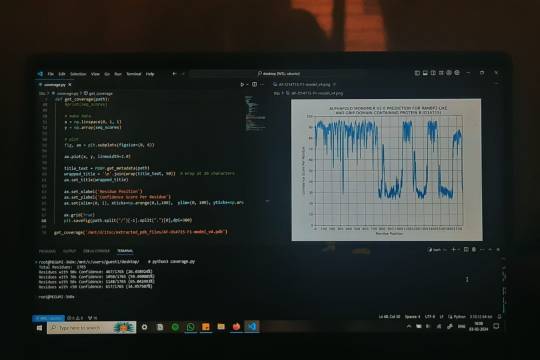
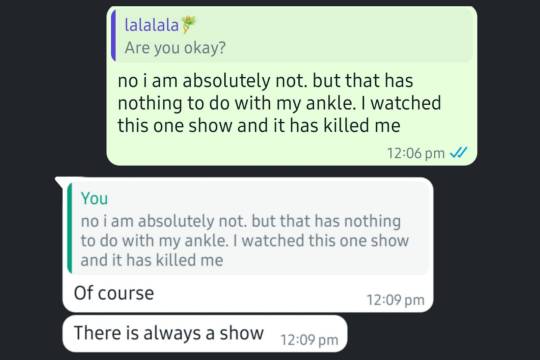
this week on megumi.fm ▸ the ankle incident
🏥 guess who twisted their ankle and ended up with a partial ligament tear and restrictions on mobility T-T I went to the doc and he gave me my meds and told me to sit my ass down for the whole month. so all I've been doing lately is throwing tantrums and zooming around the house in my trusty computer chair. it's gotten better oveer the days though, I can't wait until it fully recovers ahhhh :"
📋 Tasks
💻 Internship ↳ read papers on alphafold and it's coverage [3/3]✅ ↳ update tracker and alphafold notes ✅ ↳ complete ppt for lab presentation ✅ ↳ code to determine seq coverage depth of an AF.pdb file ✅ ↳ code to plot a per residue confidence of an AF.pdb file ✅ 🩺Radiomics Project ↳ call with PI to discuss about annotation limitations and radiomic feature selection✅ 📧 Application-related ↳ collected referee report from my profs ✅ ↳ submitted masters application for 1/1 Uni ✅
📅 Daily-s
🛌 consistent sleep [?/7] (i've been going to bed early enough but been in too much pain to actually sleep well) 💧 good water intake [7/7] 👟 exercise [/7] ankle recovery brrr
Fun Stuff this week
💗 my aunt and grandad came to visit! my cousin also showed up a couple days after, we spent a lot of time bickering with each other it was fun 💗 a completely different aunt and their family also came home this week for lunch! 📞 I've been on constant calls with a lot of my friends and talking to them. my besties and I also designed a cute little pinterest board for this story idea we have been discussing together [previous antics with said besties include painting mugs for christmas and getting hazelnut lattes for dinner] 📺 ongoing: Marry my Husband, Cherry Magic Th, Love for Love's Sake 📺 binged: My Man is Cupid, Our Dating Sim, Jun & Jun 📺 rewatch: Semantic Error 📊 on this note I also made a tier ranked list of all the asian tv (excluding anime/ghibli) I have consumed. it was fun xD 📹 This Serotonin Boost>> the leads from Love For Love's Sake being cute and clingy and affectionate with each other
📻 This week's soundtrack
Siren by Kailee Morgue All I really want is you, by the Marías
---
[Jan 29 to Feb 4 ; week 5/52 || not the most productive version of myself but given that I'm stuck cooped up in my room all day I've been doing the best I can. one of my uni applications is submitted! few more to go.
also. on a completely different note, Love for Love's Sake is such a good show?? i'm obsessed with the mechanics of the story universe and the cinematography and the narrative structure combined with the characters personalities and the parallels and that there's so much open to interpretation and. yea. it has changed me ]
#52wktracker#studyblr#study blog#studyspo#stemblr#stem student#study goals#student life#college student#studying#stem studyblr#adhd studyblr#adhd student#study motivation#100 days of productivity#study inspo#study inspiration#gradblr#uniblr#studyinspo#sciblr#study aesthetic#study blr#study motivator#100 days of self discipline#100 days of studying#stem academia#bio student#100 dop#100dop
28 notes
·
View notes
Photo

Southern Europe in the Age of Revolutions
"Southern Europe in the Age of Revolutions" offers a detailed account of the revolutions in Spain, Naples, Portugal, Piedmont, Sicily, and Greece in the 1820s. The author’s focus complements other studies emphasizing revolutions in British North America, France, Haiti, and Spanish America to provide more thorough coverage of the Age of Revolutions. This book, well suited for scholars and students, guides readers through a tumultuous period in southern European history and is highly recommended.
From the outbreak of war in the 13 British North American colonies in 1775 to the conflicts that erupted throughout the Spanish New World colonies in the 1810s, revolutions convulsed the Atlantic World for half a century. The power and consequences of the revolutionary wave that swept throughout the Atlantic should not be understated. Scholars have spent a great deal of time examining the birth of the United States, the French Revolution, the Haitian Revolution, and the Spanish American Revolutions. However, contends Maurizio Isabella, currently Professor of Modern History at Queen Mary University of London, scholars have spent far less time on revolutions in southern Europe, such as the simultaneous revolutions in Spain, Portugal, Piedmont, Naples, Sicily, and Greece. Although southern Europe has long been absent or minimized in the vast scholarly literature on the Age of Revolutions, Isabella demonstrates that the books that have dismissed or neglected these struggles need revision and argues for a broader understating of a critical period in world history.
Southern Europe in the Age of Revolutions is divided into four parts. Part I, “War, Army and Revolution” contains five chapters that explore the complex relationship between the army, war, and revolution. Chapter Five, “Crossing the Mediterranean,” is particularly noteworthy. Isabella examines three individuals involved in the revolution in Sicily – Sir Richard Church, Emmanuele Scordili, and Andrea Mangiaruva – to illustrate mobility and conflict as well as connected revolutions and counterrevolutions throughout the Atlantic World. Part II, “Experiencing the Constitution: Citizenship, Communities and Territories” includes three chapters about petitions, political culture, and demands from the people. The people did indeed speak. As Isabella notes in Chapter Seven, “Electing Parliamentary Assemblies,” revolutions during the 1820s, in contrast to pre-revolutionary electoral practices, saw national assemblies elected by quasi-universal suffrage. Part III, “Building Consensus, Pracising Protest: The Revolutionary Public Sphere and its Enemies” analyzes, throughout three chapters, the birth of a revolutionary public sphere. Readers will particularly appreciate Chapter Ten, “Taking Control of Public Space,” which discusses revolutionary ceremonies and the fascinating role singing played in this revolutionary moment. Finally, Part IV, “Citizens or the Faithful? Religion and the Foundation of a New Political Order” concludes with two chapters covering the relationship between constitutional culture and religion. Chapter Twelve, “Christianity against Despotism,” cautions against making assumptions about religion and revolution. Indeed, southern European constitutionalism placed a tremendous amount of emphasis on a religious definition of the nation, and religious figures joined both revolutionary and counterrevolutionary camps.
Throughout the book, Isabella contends that revolutions in southern Europe were part of the same global crisis of sovereignty as other revolutions throughout the Atlantic World. Thus, rather than treating them as minor events – as other studies of the Age of Revolutions have done – Isabella offers a detailed and incisive analysis of the revolutions and the people who drove them. That point is also critical. Isabella does not focus exclusively on theoretical debates but, rather, seeks to explore how the population at large experienced constitutions and revolutions. Critically, these revolutions “politicised new sectors of society, generated unprecedented quantities of printed material and fostered the discussion of novel ideas and experimentation with practices such as elections” (28). Isabella introduces readers to a wide array of people – revolutionaries and counterrevolutionaries, soldiers and civilians, elites and the masses, religious and non-religious, men and women – and shows how these people experienced the tumult of revolution and new political awareness. Southern Europe in the Age of Revolutions makes an important contribution to scholarly understandings of the Age of Revolutions, and Isabella anchors his analysis in extensive primary and secondary sources. This book will appeal to students and scholars interested in revolutions, politics, and Atlantic history.
Continue reading...
18 notes
·
View notes
Text
Support Entertainment Workers On The Strike Line
"Roughly 172,000 entertainment workers are currently striking, and many are walking picket lines across Los Angeles this summer during an historic heat wave. For the first time in over 60 years, the Writers Guild of America (WGA) and the Screen Actors Guild/ American Federation of Television and Radio Artists (SAG-AFTRA) are on strike at the same time, essentially halting entertainment production as members seek a fair contract. Picketers outside production giants like Amazon, Disney, Netflix, Paramount, Sony, Universal and Warner Brothers are braving blistering conditions 5 days a week this summer in order to make their voices heard demanding higher wages, calling out unfair streaming compensation packages, the lack of regulation around the use of AI, and many more unjust grievances.
Regarding the timeline for a resolution, one studio executive was quoted as saying, “The endgame is to allow things to drag on until union members start losing their apartments and losing their houses.” Right now, this strike is the front line of the labor movement.
You can find a picket line here: https://www.wgacontract2023.org/strike/picket-schedules-and-locations
The Plan
Community Solidarity Project is a 501(c)3 nonprofit that works to support organizations and campaigns in their work for justice and empowerment through event production, logistics management and donation gathering. As the entertainment industry, which is at the heart of Los Angeles, walks off the lot in the name of just and modernized working conditions, our organization is a grassroots partner to striking members in the struggle for workers' rights in 2023.
We are working alongside Strike Captains to mobilize and allocate community resources to support members on the line. With all eyes on Hollywood, consistently strong and well-populated picket lines are a crucial component to showing the media and studio bosses how much public support there is for workers' rights.
The Programs
We have partnered with local grocery stores as well as Best Food Trucks to bring weekly donations of water, sports drinks, fresh fruit, and lunch to a minimum of four picket lines for an initial period of 4 weeks, with the potential to go longer if the strikes continue.
Water, sports drinks & fruit: This effort is already underway, with resources being delivered to four strike lines weekly starting the week of Monday, July 17.
Lunch from Best Food Trucks: This partnership enables us to regularly bring high quality lunches to picketers on a reliable schedule.
Financial Goals
In order to sustain these efforts, we need to raise a minimum of $3200 per week. Here's how those numbers break down:
$6/lunch x 100 people x 4 studio locations = $2,400/week
5 cases/water + 5 cases/sports drinks + 2 cases/fruit x 4 locations = $800/week
As this effort grows, we could aim to cover 10 separate strike lines, 5 days a week! But to get this off the ground, we need to start with the first week at the $3200 mark, and then the first month at a minimum $12,800. By that time, we hope to be exceeding our goals and growing the amount of coverage this effort can sustain.
Historical Significance
Since the mid-1800s, Los Angeles has been a Union Town. At that time, workers in professions such as baking, cigar making, metalworking, printing, and carpentry organized themselves to demand better conditions and fair wages from bosses. Filmmaking began to unionize in the 1890s when IATSE - the International Association of Theatrical and Stage Employees - formed in response to worker exploitation in that industry. Within a few short decades, the Writers Guild of America (WGA), the Screen Actors Guild (SAG), and the American Federation of Television and Radio Artists (AFTRA) all took root in Hollywood in order to protect the labor and talent upon which filmmaking and entertainment are built. Today, those labor organizations are rising up again to protect the workers in a modernized entertainment industry.
Support the labor movement today in a uniquely Los Angeles way, by providing much needed sustenance to striking entertainment workers."
#fans4wga#sag-aftra strike#sag strike#union solidarity#writers guild strike#actors guild strike#wga strong#i stand with the wga#actors strike#wga strike#writers strike
83 notes
·
View notes
Text
Fujinon ZK19-90mm T2.9 Cabrio Zoom Lens Review
Fujinon ZK19-90mm T2.9 Cabrio Zoom Lens Review
For professional broadcast house and independent cinematographer use, as well as for cinema performance and flexibility, Fujinon ZK19-90mm T2.9 Cabrio lens is the go-to choice. Pros and distributors such as The Broadcast Store always talk about it due to its dependability and ENG-style functionality.
Designed to support Super 35mm cameras, the ZK19-90mm leverages the wide-to-telephoto zoom range flexibility with the accuracy, cinematic appearance demanded by today's content creators. From film and television production, commercials, and live broadcast productions, the ZK19-90mm offers clean, reliable images with low distortion.
Engineered for mobility and usability, the lens reconciles optical performance and manufacturing efficiency. It belongs to the Fujinon Cabrio line, which has worked to marry the finest ENG and high-end cinema.
Features:
Focal Length: 19mm to 90mm — suitable for wide-angle and mid-telephoto applications
Aperture: Fixed T2.9 throughout the zoom range
Mount Type: Industry standard PL mount
Sensor Coverage: Super 35mm (31.5mm image circle)
Weight: Approximately 2.85 kg with servo
Servo Unit: Field removable for ENG-style handheld application
Focus Rotation: 200° for glitch-free pull focus techniques
Compatibility: ARRI LDS & Cooke /i metadata systems compatible
Advantages to Filmmakers and Videographers
The ZK19-90mm isn't another lens—it's a durable tool designed to handle diversified applications. These tremendous advantages are some of the greatest reasons it surpasses experts:
Professional-Grade Optics
Delivers 4K-ready sharpness with reduced chromatic aberration
Minimizes focus breathing for silky-smooth racking between subjects
Built-In Servo Drive
Used as a broadcast zoom lens with a zoom rocker
Removable, reserving the lens for ENG and cinematographic configurations
Ease of Use
No on-the-fly lens change required—perfect for high-speed shoots
Lightweight and compact for easier handheld or gimbal use
Use Cases
No matter your broadcast studio, commercial video, or independent film, the ZK19-90mm can be shaped to fit your needs. Its hybrid structure excels at:
Narrative Production of Film
Commercial and TV Shoots
ENG-Style and News Broadcast
Documentary filming
Live Event coverage
Why the Fujinon ZK19-90mm is a professional's choice
Pro professionals worldwide rely on this lens for image quality and build. Directors like the aspect of being able to shoot a myriad of different situations through one lens without compromising on quality.
The Broadcast Store is recommending it to rental facilities, studios, and independent producers seeking a high ROI purchase. It offers:
Repeatability at focal lengths
Lighter equipment load due to its one-box design
Robust build construction appropriate for demanding production conditions
Bullet Point Summary
Wides to medium telephoto (19-90mm)
Uniform T2.9 aperture
Lightweight servo removable
Universal compatibility with standard cine accessories (0.8 pitch gears)
Metadata protocols (LDS & /i) integrated
Used by The Broadcast Store for broadcast and film
Conclusion
The Fujinon ZK19-90mm T2.9 Cabrio Lens is not only a cinema zoom, but also an all-around unit that has been built to withstand the extreme demands of professional DPs in film, television, and broadcast. Its adaptability to accommodate both cinema and ENG-style shoots makes it an all-inclusive package for a wide variety of content creation.
Approved by The Broadcast Store and used by production experts, the ZK19-90mm boasts superior image quality along with handy features such as servo removable and standard industry mount. It's not only a lens—it's your trusted partner on the journey along your creative journey.
Whether shooting a feature film or a live production or broadcast segment, this lens is poised to give you good output.
2 notes
·
View notes
Text
Blog Post Due 4/10
In what ways have hashtags been used to help racial injustice?
Hashtags have been used commonly throughout the online world, but in black Twitter they mean something completely different. Laytoya Lee’s article Black Twitter: A Response to Bias in Mainstream media, explains how organized groups in the black Twitter community use hashtags like #AliveWhileBlack, #ICantBreathe, or #APHeadlines were used in order to demonstrate online activism and support to protests happening at the time. Additionally, by using the hashtags or what Lee refers to as “blacktags” they can be used like a search engine, in order to see specific posts/news for the related event. The black tags were created in response to Black Lives Matter protest, the killing of innocent black people from police brutality, and to raise awareness of events in the black community.
How did social media play a role in the #NoDAPL movement?
Deschine Parkhurst explains in her article that when the #NoDAPL movement first occurred it hadn’t really received any mainstream coverage from national news sources like NBC, CBS, or CNN. While the protest did have citizen journalists, independent media, and posts being made there was no mainstream news coverage about what exactly was happening during the movement. Until a facebook live streaming of militarized police using excessive force on Water Protectors helped gain national attention for the cause. The live streaming was the gateway for the #NoDAPL movement to get the attention that they needed and deserved. Social media was used to amplify, spread the word, and for people to create a community of support for the movement.
What is online activism?
In the article, Classifying Forms of Online Activism by Sandor Vegh, the author introduces the term “online activism”. In which they describe as “a politically motivated movement relying on the Internet”. In other words, using the internet as a tool in order to help give political protests, events, or movements gain attention to have more people support their cause.
What are some forms of online activism?
Andor Vegh’s article goes into detail about the many ways that online activism can take place. A quick overview of the forms is awareness/advocacy, organization/mobilization, and action/reaction.
First off, awareness and advocacy is used to inform other people about what is happening. This form is created by accessing relevant websites and news information, which can be provided by the individuals or independent organizations involved with the event.
Moving on, organization and mobilization is the physical action taken for the protest or movement. While this form still uses the internet to spread word about plans or offline events, it is mainly just used as a messenger to coordinate large gatherings. Additionally, organization and mobilization utilities emails, website postings, or contacting government officials to help stand with the cause at hand.
Finally, action and reaction is based on the internet only. This form is used in a way such as spam email or messaging to overrun servers. The goal of this form is to overwhelm the response capacity or stop servers from properly working.
In all, each of these forms of online activism utilize the internet in different ways. Whether that be news coverage to spread the word about the event or planning physical meetups to show support for certain causes. Online activism has many forms for people to participate in protests or political movements.
Lee, L. A. (2017). Black Twitter: A Response to Bias in Mainstream Media. Social Sciences, 6(1), 26. https://doi.org/10.3390/socsci6010026
ReferencesParkhurst, D. (2021). 2. From #Mniwiconi to #StandwithStandingRock: How the #NoDAPL Movement Disrupted Physical and Virtual Spaces and Brought Indigenous Liberation to the Forefront of People’s Minds. Rutgers University Press EBooks, 32–47. https://doi.org/10.36019/9781978808812-003
Vegh, S. (2003). Classifying Forms of Online Activism .
3 notes
·
View notes
Text
Straight from the floor of Congress…
Important read on current efforts to gut our government programs. Please share EVERYWHERE.
Report from the Senate Floor:
“Last night in the Senate, something really important happened. Republicans forced us to debate their billionaire bailout budget framework. We started voting at 6 PM because they knew doing it in the dark of night would minimize media coverage. And they do not want the American people to see how blatant their handover of our government to the billionaire class is.
So I want to explain what happened last night and what we did to fight back. The apex of Republicans’ plan to turn over our government to their wealthy cronies is a giant tax cut for billionaires and corporations. And they plan to pay for it with cuts to programs that working people rely on. Popular and necessary programs like Medicaid, Medicare, and SNAP, are all being targeted.
In order to pass the tax cut, Republicans have to go through a series of procedural steps. Last night, they took the first step which requires them to pass an outline of their plan, but with it, any senator can offer as many amendments as we want. So my Democratic colleagues and I did just that.
Now, we knew that Republicans would largely unanimously oppose them, but we had two objectives here. One, Republicans were forced to put their opinion on record — many for the first time — on the most corrupt parts of Trump and Musk’s agenda. Two, as I’ve been saying, I am going to make every process and procedure as slow and painful as possible for as long as my colleagues choose to ignore the constitutional crisis happening before our eyes.
So what did we propose? We proposed no tax cuts for anyone who makes a billion dollars a year. We made them vote on whether or not Elon Musk and DOGE should have limitless access to Americans’ personal data. We made them vote on whether to protect IVF and require insurers to cover it. Every single amendment Democrats proposed was shot down. On almost every single amendment, Republicans universally opposed it. Every Republican voted against our proposal to prevent more tax cuts for billionaires. The corruption and theft is happening in the open here.
The whole game for Republicans is taking your money and giving it to the wealthiest corporations and billionaires — even if it means kicking your parents out of a nursing home or turning off Medicaid for the poorest children. They know what they are doing is deeply unpopular. They are offering a tax cut to the most wealthy that is 850 times larger than what they are offering working people. Oh and by the way, any tax cuts for working people are going to be washed out by higher costs for basic necessities, like health care and food. It’s a fundamental injustice.
Thanks to your pressure and support, many of my Democratic colleagues have joined my effort to do everything we can to make sure they cannot destroy democracy and steal your money in the dark of the night. We are being loud about what is happening. I’m going to continue to grind the gears of Congress down as much as possible to make it that much harder and slower to get away with this corruption. That’s why the votes lasted until nearly 5 AM.
This is a five-alarm fire. I don’t think we have two years to plan and fight back. I think we have months. It’s still in our power to stop the destruction of our democracy with mass mobilization and effective opposition from elected officials. So we can’t miss any opportunity to take advantage of opportunities to put Republicans on the record and shine a light on what is happening.
And you have a role to play in this as well. I need you to amplify what’s happening, support the leaders who are fighting for you to make sure they can continue speaking truth to power against Musk and Trump’s billionaire cronies, and show up at rallies and town halls. Use every tool at your disposal to send a message loud and clear about how you expect my colleagues to lead and fight in this moment.
Every best wish,”
US Senator Chris Murphy (D - CT)
5 notes
·
View notes
Text
Ahmed Baba at Substack:
We exist within a Disinformation Age where our media consumption is fragmented, and there are no universally agreed-upon facts. Our social media feeds are at the whim of corporate-engineered personalized algorithms that are designed to reinforce our preexisting biases and capture our attention at all costs - even if that cost is the truth. Gone are the days of the dominant Big Three networks - ABC, NBC, and CBS - and major newspapers delivering centralized news in the mid-1900s. Americans now receive their news from a wide array of sources, from podcasters to social media creators. The gatekeepers are gone. While this has created great opportunities for honest independent media to rise, the incentive structure of an internet dominated by the attention economy encourages shameless, lying grifters as well. [...]
This information environment has been expertly utilized by a right-wing media ecosystem that weaponizes lies to exploit Americans’ distrust in institutions and innate human vulnerabilities - all for Trump’s benefit.
In the face of this incredibly well-funded, right-wing disinformation machine, there is no liberal equivalent pushing back. There is, of course, the mainstream media that sees its work as upholding objective reality, but it’s often plagued by false equivalency and both-sideism. Unfortunately, in the 2024 election cycle, it was clear that this wider mainstream media ecosystem didn’t always live up to the highest potential of the Fourth Estate. Just to be clear up front, I don’t subscribe to the broad, unnuanced attacks on the media. My take is more balanced. I agree that many outlets did, in fact, sanewash Trump’s unhinged rants, making him more palatable to voters, and Kamala Harris faced an unmistakable double standard in a lot of the coverage. However, I also recognize that there were bright spots in the 2024 election coverage that did work to accurately spotlight the threat of a second Trump term. During the 2024 election cycle, many journalists did phenomenal work. Mainstream networks like MSNBC constantly spotlighted the threats of Project 2025, and publications like ProPublica did invaluable investigative reporting. The New York Times also did excellent reporting but was often weighed down by its opinion page and poorly worded headlines. [...]
We Need More Fearless Pro-Democracy Journalism
I documented every day of Trump’s presidency during his first term, so I know a thing or two about how Trump operates. I also spent the past year writing and making appearances on MSNBC warning about Project 2025. I’ve also delivered guest lectures about media literacy in the Disinformation Age to thousands of middle school, high school, and college students over the past two years. Throughout all this work, I’ve come to the conclusion that journalists have to grow increasingly innovative with how they present truth and safeguard democracy. In the very first article I wrote in this newsletter last year, I argued why the media should be unapologetically pro-democracy, and I warned that the media was making similar mistakes they made in 2016. I wrote that journalism should act as American democracy’s immune system, rejecting the sickness of authoritarianism. Like the antibodies we develop after infection or immunization from a virus, journalists should recognize the historical patterns of authoritarianism, inform voters of its corrosive impacts, and trigger the public to mobilize against it.
That is what we need now, more than ever. Amid an avalanche of disinformation and outrage bait, members of the media should not only relay facts but help Americans interpret those facts with contextualized analysis. They’ll need to focus on the impact of policies and actions, not just the optics. As NYU Journalism Professor Jay Rosen says, journalists need to highlight the stakes, not the odds. Steven Bannon once said, “The real opposition is the media. And the way to deal with them is to flood the zone with shit.” Journalists need to keep this in mind. Trump’s chaotic moves are often part of a strategy of distraction. We need to be on guard and parse through what truly matters and where we should direct the attention of the American people.
We know the Project 2025 playbook. Watch for moves to dismantle independent agencies, consolidate executive power, and undermine democratic safeguards. Journalists must call these out early and clearly. I’ve already been seeking to do that myself by spotlighting Trump’s hiring of Project 2025 loyalists. Covering Trump’s avalanche of lies will also be challenging. According to The Washington Post, President Trump told over 30,000 lies while in office, including the Big Lie that the election was stolen – a lie that would lead to an illegal attempted overthrow of American democracy by his own supporters. Journalists should cover Trump like the documented liar he is and never take what Trump says at face value or report his words verbatim and unchecked. When they catch Trump lying, they should not only fact-check but also place those lies in the broader context of Trump’s strategy. Focus on the why as much as the what. True objectivity isn’t fake neutrality. It’s upholding objective reality against disinformation. Anything less is a bias toward the liar. This is how the media should cover Trump's lies.
@Ahmed Baba wrote a solid piece detailing how media outlets should properly cover a 2nd Trump term: report the truth about Trump’s lies and autocratic aims fearlessly.
4 notes
·
View notes